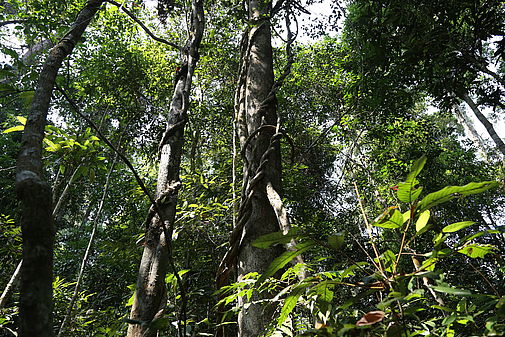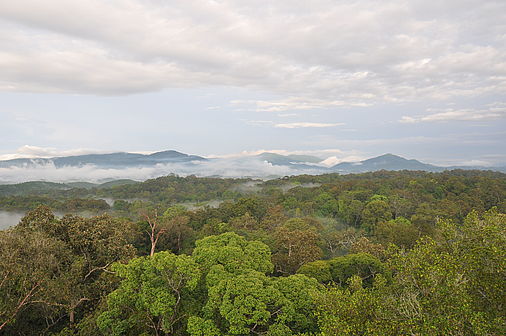Overcrowding increases tree mortality, perhaps explaining higher biodiversity in tropical forests
International research team analyzed patterns of tree mortality across a global network of large-scale forest plots
28 February 2024
Social distancing is not only helpful to prevent the spread of human diseases but may also promote coexistence of different tree species and explain why there are more tree species in tropical forests. This was found by a team of 52 scientists from around the world, led by Lisa Hülsmann, Professor of Ecosystem Analysis and Simulation at the University of Bayreuth, and Florian Hartig, Professor of Theoretical Ecology at the University of Regensburg, who analyzed patterns of tree mortality across a global network of large-scale forest plots coordinated by the ForestGEO program at the Smithsonian Tropical Research Institute.
Their results, just published in Nature, show that trees experience higher mortality when surrounded by neighbors of the same species, probably caused by specialized pathogens or herbivores. The effect is present in forests all over the world, but it is more pronounced among rare tropical tree species, perhaps contributing to the astounding biological diversity of tropical forests compared to forests in temperate areas.

Mo Singto Forest, Khao Yai National Park, Thailand. Credit: Lisa Hülsmann
How tropical forest communities can support hundreds of species without one species becoming dominant and others going extinct has puzzled ecologists over centuries. More than 50 years ago, ecologists Daniel Janzen and Joseph Connell hypothesized that the stable climatic conditions in the tropics allow pathogens to specialize more strongly on individual tree species, causing trees to grow less and die more frequently when surrounded by other trees of the same species - a reaction called density dependence. If this density dependence increases towards the equator, this could explain the increase in tree species diversity towards the equator.
Ecologists have long sought evidence of this phenomenon. But, until now, they did not have the data and analytical tools to compare the strength of the mechanism between tropical and temperate forests. The large international research team now used new methods and data to find out whether the hypothesized mechanism really exists.

Pasoh Forest Reserve, Malaysia. Credit: ForestGEO
"The nearly 2.5 million trees monitored at 23 sites worldwide show density dependence, but not necessarily more towards the tropics," says Lisa Hülsmann. But in tropical forests, species with stronger density dependence tended to be less abundant. The authors of the study suspect that this pattern is due to a more effective regulation of population sizes in tropical forests. This in turn could contribute to the comparatively high species diversity.
According to Florian Hartig, the results are partially consistent with Janzen and Connell's idea. Specialized pathogens may indeed have a stronger influence on tropical biodiversity than in temperate forests, but the link is more subtle than suspected.
Stuart Davies, Director of the ForestGEO network, states: “This study illustrates the fundamental importance of long-term, large-scale studies of the world's forests to elucidate the key processes that sustain biodiversity in these critical ecosystems.”
The results of this study offer valuable insights into the mechanisms that influence biodiversity in tropical and temperate forests. Especially in times of climate change, the highly specialized interactions between trees and pathogens could be disrupted, with potentially unfavorable effects on local tree species diversity. However, the researchers emphasize that further studies are needed to fully understand the implications of these findings for tree species diversity in different forest ecosystems.

The Bavarian Climate Research Network bayklif, funded by the Bavarian State Ministry of Science and the Arts, supported the research. The researchers obtained the forest data for the analysis from the ForestGEO network, which is part of the Smithsonian Institute.
Original Article:
Hülsmann et al., Latitudinal patterns in stabilizing density dependence of forest communities, Nature 2024, doi 10.1038/s41586-024-07118-4
Information/Contact
Prof. Dr. Florian Hartig
Theoretical Ecology
University of Regensburg
Jun. Prof. Dr. Lisa Hülsmann
Ecosystem Analysis and Simulation
University of Bayreuth
Prof. Dr. Stuart Davies
Director of the Forest Global Earth Observatory (ForestGEO)
Smithsonian Institution




